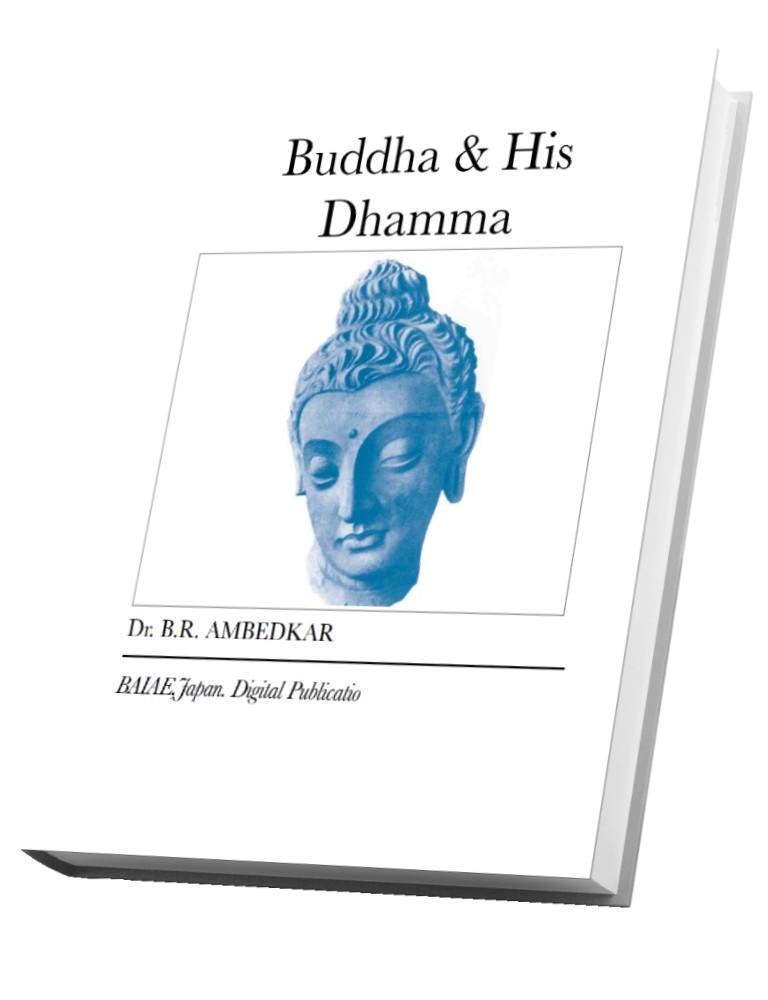Buddhism
Buddhism is an ancient Indian religion found by a prince named Siddhartha Gautama in the 5th century BCE (exact date uncertain). He is called the Buddha after attaining enlightenment. Currently about 7% of the global population are Buddhists and is the fourth largest religion in the world. Very few Buddhists now live in India, while the majority live in East and Southeast Asia. Currently only 7 countries have majority of their population believing in Buddhism: Cambodia, Thailand, Myanmar, Bhutan, Sri Lanka, Laos and Mongolia. However, Buddhism concepts, such as Saṃsāra (cycles of rebirth) and karma (deed and effect), are infused with indigenous beliefs in many countries, such as China and Japan.
Below is a statue of Buddha teaching in the lotus position, found in Sarnath, Uttar Pradesh, India:
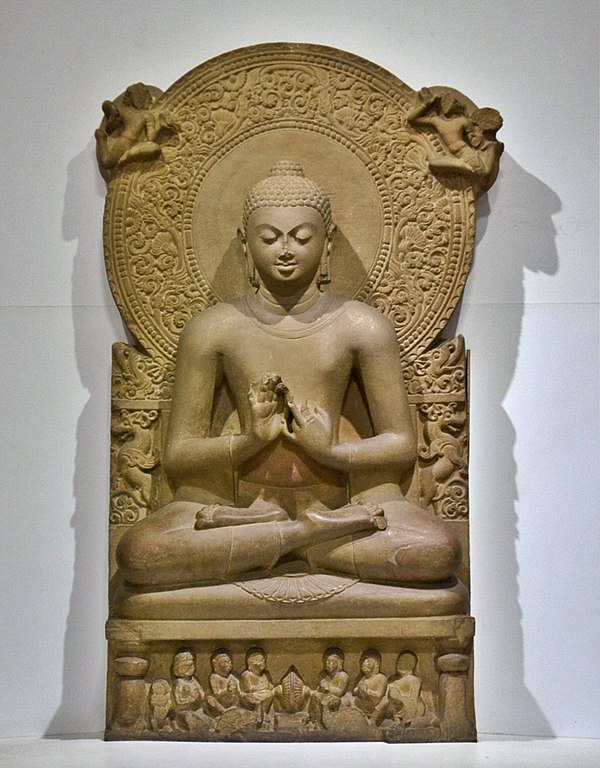
Buddha died around 450 BCE. About 500 of Buddha's followers gathered together approximately 30 years after the death of Buddha to collectively preserve the teachings of Buddha (called the first Buddhist council). The main results are (1) the rules for his followers and (2) a collection of discourses by Buddha (called the Nikaya). These discourses formed the doctrinal foundation of Buddhism. They were initially transmitted orally and later put into writing. Subsequently there were two more Buddhist councils in India (one held around 383 BCE and the other around 250 BCE).
These are some of the doctrines in the Nikaya:
(1) Three universal truths
-- Impermanence: Everything in life is impermanent and always changing.
-- Nonself: There is no eternal, unchanging soul.
-- Nirvana: We can reach a state of joy in which ideas, concepts, and suffering can be completely extinguished.
(2) Four noble truths
-- The truth of suffering (Dukkha)
-- The truth of the origin of suffering (samudaya)
-- The truth of the ending of suffering (Nirodha)
-- The truth of the path to the end of suffering (Magga)
(3) Noble eightfold path
--Right View (Samma Ditthi)
--Right intention (Samma Sankappa)
--Right speech (Samma Vaca)
--Right action (Samma kammanta)
--Right livelihood (Samma Ajiva)
--Right effort (Samma Vayama)
--Right mindfulness (Samma Sati)
--Right concentration (Samma Samadhi)
This is a mural showing the gathering of the first Buddhist council, found in Nava Jetavana temple, Jetavana Park, Shravasti, Uttar Pradesh, India:
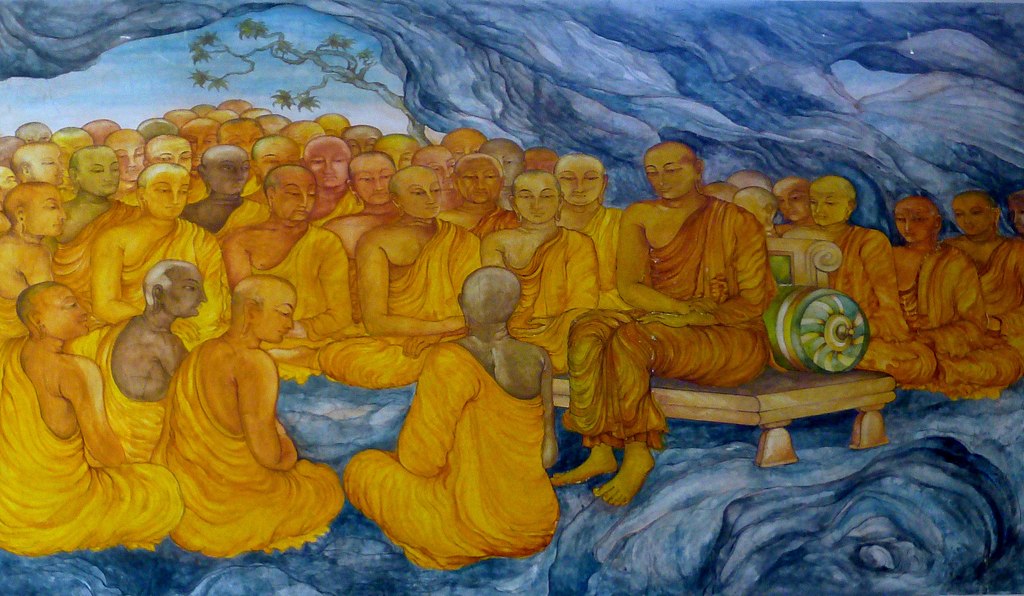
Starting from about 200 yeas after the death of Buddha Buddhism was split into different schools totaling approximately 18 due to doctrinal differences and geographical separation of followers. From these schools eventually three main traditions of Buddhism were formed: (1) Theravada, (2) Mahayana, and (3) Vajrayana. Buddhists today generally belong to one of these traditions.
Theravada mainly followed the original doctrines. Today its followers live mainly in Sri Lanka and continental Southeast Asia.
Mahayana developed around 100 CE. It added new doctrines and numerous Mahayana texts to support the doctrines. Slowly Buddha was turned into a mystical being with magical powers. Today its followers live mainly in China, Japan, Korea and Vietnam. In China, the followers are mainly of the Han ethnic group, which constitutes more than 90% of its population.
Vajrayana developed around 600 CE. It drew on the Mahayana doctrines and add pan-Indian tantric ideas to create new Buddhism doctrines. New texts and practices were also introduced to support the doctrines. Today its followers live mainly in Tibet, Mongolia and Bhutan.
As mentioned above, Buddhism had many schools and traditions. There were intense competitions among them. Further, Buddhism also needed to compete with other Indian religions and Hinduism schools. As a result, Buddhists developed skills that included logic and rhetoric. Later, some Buddhists believed that logic could be a path to enlightenment. Thus, Buddhist logic is different from the logic developed in Europe.
At the time of Buddha's death there were many schools of Hinduism and other religions in India. Buddhism was merely one of them. Buddhism spread only slowly in India until the time of Mauryan Emperor Ashoka (304-232 BCE). He publicly supported Buddhism. After the third Buddhist council (held around 250 BCE) the Emperor sent monks well versed in Buddhism to nine different countries. This trend to send missions continued throughout the Mauryan empire (322-184 BCE). By the 1st century CE, many parts of the ancient world had heard of Buddhism. See the map below.
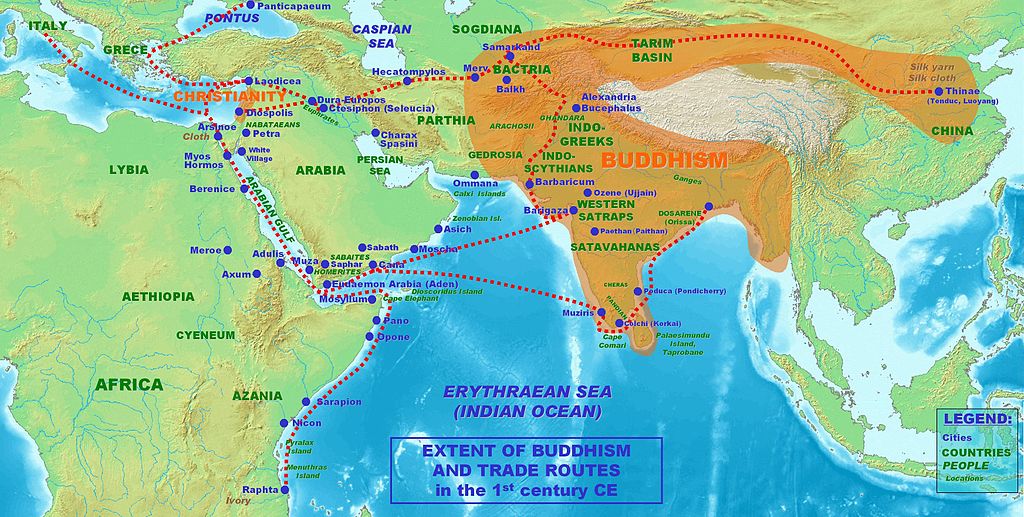
It is not clear exactly how influential the interactions to Egypt and Greece may have been. The missions to Sri Lanka, the Silk Road, and present day Afghanistan were very successful. Lots of people in these areas were converted to Buddhism. Many monks there traveled to China and translated Buddhist scripts to Chinese (some mastered the Chinese language and others relied on helps from Chinese followers). After the rise of Islam and military expansion of the caliphates, many countries in Silk Road and Afghanistan became Islamic countries. But the spread of Buddhism to China took hold and China became an important center of Buddhism.
As mentioned above, different Buddhist tradition developed in India. These traditions spread outside of India at different times, depending on the time the traditions were formed. Below is a map showing the spread of the different traditions.
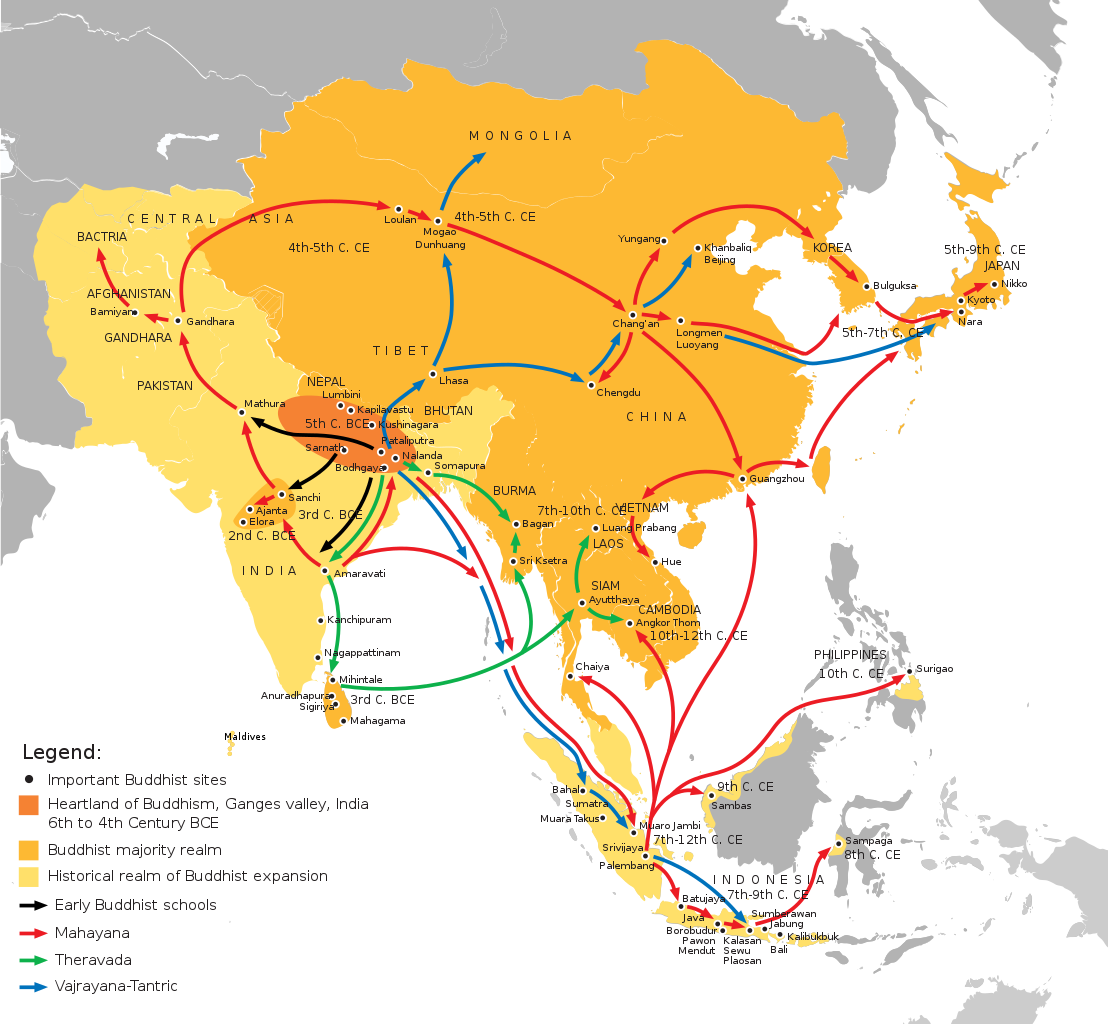
Buddhism had spread to Sri Lanka starting from the Mauryan empire. Theravada tradition was the only tradition available. Thus Sri Lanka is a stronghold of Theravada. This tradition then spread to the continental Southeast Asia and took hold there. Today Buddhists in these areas are predominately Theravada.
When Buddhism spread to the Silk Road and then China around 100 CE, the Mahayana tradition started to take shape in India. The doctrines of Mahayana were more compatible with Chinese culture. As a result, Mahayana became popular in China and Vietnam (which, for a long time, was ruled by China). From there Buddhism then spread to Japan and Korea.
Buddhism did not spread to Tibet until around the 7th century CE. However it lasted only a brief period of time. It was Padmasambhava, a 8th or 9th century CE Indian Vajra master, who became a central figure in the transmission of Buddhism to Tibet. After him, there were extensive contacts between India and Tibet -- Indian monks went to Tibet to spread Buddhism and Tibetan monks traveled to India to learn and bring back Buddhist scripts for translation. At that time Vajrayana tradition was the predominant tradition in India. Thus Vajrayana was the national Buddhist tradition in Tibet. From there the tradition further spread to Mongolia.
Vajrayana was also transmitted to China around 750 CE during the Tang dynasty. The tradition was further transmitted to Japan together with Mahayana. After the Tang dynasty Buddhism was in decline in China. It still had a large number of Mahayana followers but no Vajrayana followers. One consequence was that the Vajrayana tradition disappeared in China while it survived in Japan. After about a thousand years Vajrayana tradition returned to China through Japan during the late Qing dynasty.
Although Buddhism thrived in areas such as Sri Lanka, Mongolia, Tibet and Southeast Asia, it was in decline in India starting from the 9th century CE. There were many factors involved, both internal and external. For example, the doctrines and practices of Buddhism and some Hinduism schools in India slowly converged to the point that many common people cannot separate the two. Also, as dynasties in India changed the supports to Buddhism became uneven. The Turkic invasion of the 10th century CE and the later Islamic rule made Buddhism almost extinct in India.
If you are interested in learning more about the history of Buddhism, two books are provided here. They are written in different time periods and could offer different perspectives on the history.
(1) Taranatha's History of Buddhism in India. This book was written by Lama Taranatha and then translated into English. Taranatha (1575-1634 CE) was a Tibetan Buddhist and scholar. He authored many books, some of them had been translated into English. Later, he went to Mongolia and found several monasteries there.
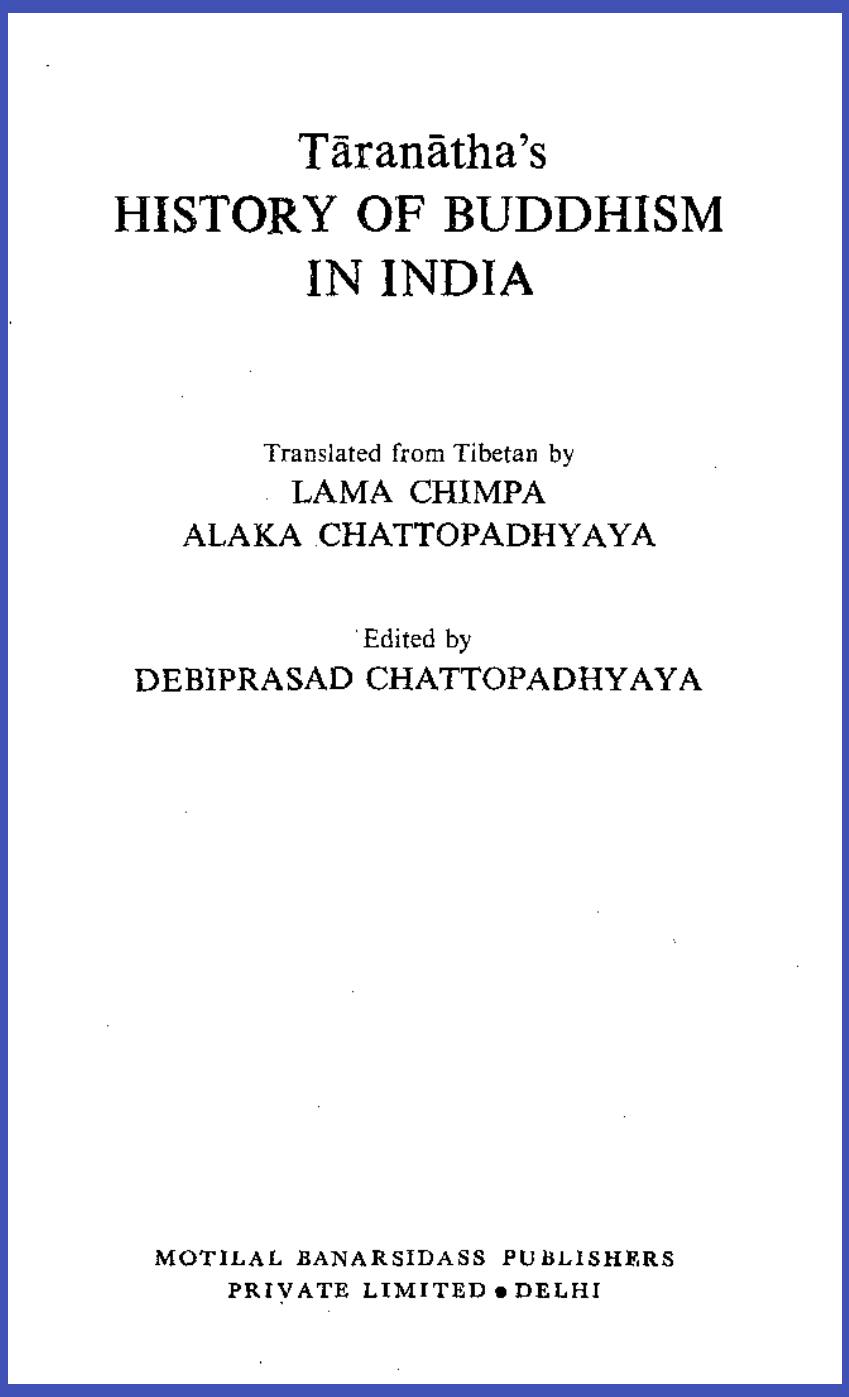
(2) The Rise and Decline of Buddhism in India (file size: about 20 MB). This is a recent book and more analytic. The title of the last chapter is illustrative, "Conclusion: No Decline but Gradual Assimilation with Brahminical Religion or Is Buddhism Really Extinct from the Motherland?"
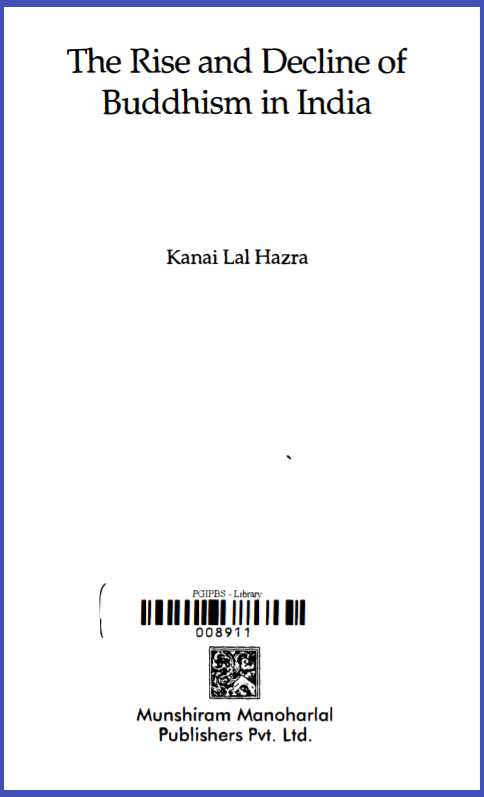
Recently there are efforts to revive Buddhism in India. In the 1950s, B. R. Ambedkar (1891-1956), who contributed significantly to India's independent and was the chairman of a committee to draft India's constitution, pioneered the Dalit Buddhist movement in India for the Dalits (formerly referred to as "untouchables"). During the last year of his life Ambedka formally converted to Buddhism along with his 365,000 followers. Many other such mass-conversion ceremonies followed (hosted by others). Ambedkar completed a book on Buddhism a few days before his death. This is his book: Buddha & His Dhamma.
